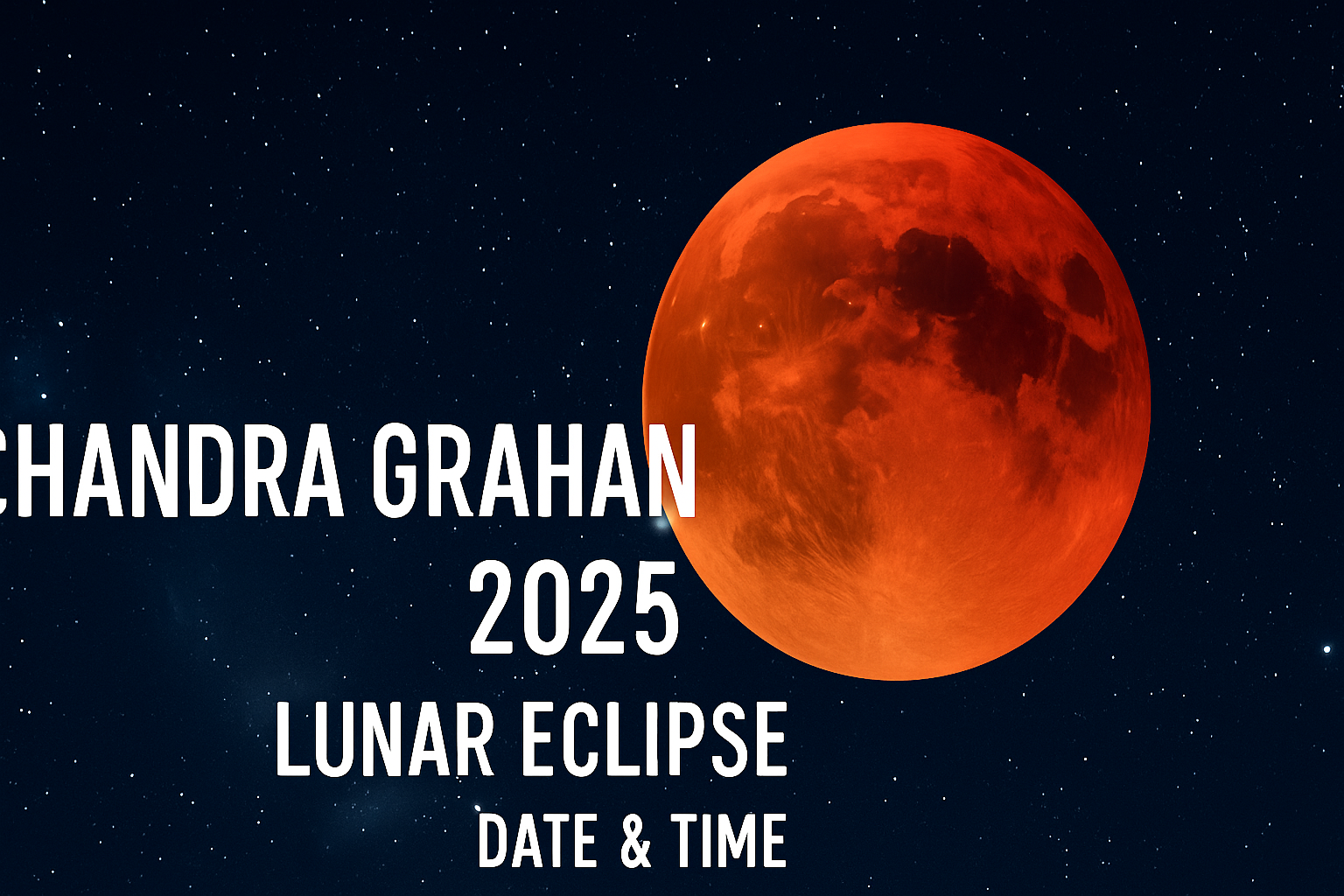Chandra Grahan 2025: The night sky will soon showcase a spectacular celestial event! If you are curious about Chandra Grahan timings, lunar eclipse time in India, or when the next full moon in September 2025 will occur, this article has everything you need.
On the night of September 7–8, 2025, a total lunar eclipse—commonly known as Chandra Grahan—will be visible across India and many other parts of the world. During this rare event, the Moon will pass through Earth’s shadow, appearing in a stunning reddish hue, often called a Blood Moon.
This eclipse is extra special because it takes place during the full moon of September, making it one of the most anticipated astronomical events of the year.
Chandra Grahan Timings in India (September 7–8, 2025)
The lunar eclipse will unfold in different stages throughout the evening and late night. Below are the complete Chandra Grahan timings for India:
| Eclipse Phase | Time (IST) |
|---|---|
| Penumbral Eclipse Begins | 08:58 PM (Sep 7) |
| Partial Eclipse Begins | 09:57 PM |
| Total Eclipse Begins | 11:00 PM |
| Maximum Eclipse | 11:41 PM |
| Total Eclipse Ends | 12:22 AM (Sep 8) |
| Partial Eclipse Ends | 01:26 AM |
| Penumbral Eclipse Ends | 02:25 AM |
- Total Duration: About 5 hours and 27 minutes from start to finish
- Totality (Blood Moon phase): 82 minutes of the Moon completely covered by Earth’s shadow
This rare total lunar eclipse will be visible across all parts of India, as well as much of Asia, Africa, Europe, and Australia, depending on local weather conditions.
September 2025 Full Moon – The Corn Moon
This lunar eclipse coincides with September’s full moon, known traditionally as the Corn Moon. Unlike some years where September’s full moon is the Harvest Moon, in 2025 the equinox occurs later in the month, making this full moon the Corn Moon instead.
- Full Moon Peak: 09:08 PM IST on September 7, 2025
This means the Moon will already be bright and perfectly positioned in the sky when the eclipse begins, creating a breathtaking visual experience.
Why the Moon Turns Red During a Total Lunar Eclipse
During a total lunar eclipse, the Moon appears red or orange, giving rise to the term Blood Moon. This beautiful phenomenon happens because:
- The Earth blocks direct sunlight from reaching the Moon.
- Light passing through Earth’s atmosphere gets scattered, with shorter blue wavelengths filtered out.
- The remaining red and orange light bends and illuminates the Moon, creating a dramatic, glowing effect.
Unlike solar eclipses, lunar eclipses are completely safe to view with the naked eye. No special equipment or glasses are required.
Cultural and Spiritual Importance of Chandra Grahan
In Indian culture, Chandra Grahan holds significant spiritual meaning. The period before the eclipse, known as Sutak, begins nine hours before the start of the eclipse. During this time, many families observe certain practices, including:
- Avoiding eating or drinking
- Refraining from starting new tasks or major decisions
- Engaging in meditation, chanting, or prayer
- Staying indoors, especially for children, pregnant women, and elderly individuals
After the eclipse ends, it is customary for many to take a ritual bath and clean their surroundings, symbolizing spiritual and physical purification.
Astrologically, this eclipse may have varying effects on different zodiac signs. Some signs may experience opportunities for growth and renewal, while others may face challenges that encourage self-reflection and inner strength.
How to View the Lunar Eclipse
Witnessing a total lunar eclipse is a truly magical experience. Here’s how to make the most of it:
- Choose an open location: Find a clear viewing spot away from city lights and tall buildings.
- Check weather conditions: Cloudy skies may obstruct the view, so plan accordingly.
- Use binoculars or a telescope: While the naked eye is enough, these tools offer a closer look at the Moon’s details.
- Photography tips: Use a camera with night mode or a DSLR with a tripod for sharp, stunning images.
- Share the moment: Invite friends and family to witness this rare natural event together.
Interesting Facts About the September 2025 Lunar Eclipse
- This is the final total lunar eclipse of 2025, making it a rare opportunity for skywatchers.
- The next total lunar eclipse visible in India will take place in 2026.
- The Moon will appear larger and brighter as it will be near its closest point to Earth (perigee).
- Unlike solar eclipses, no special glasses are required to safely view the event.
The total lunar eclipse on September 7–8, 2025 will be visible across a large part of the world, making it a global astronomical event. Here’s a breakdown of regions and countries where the eclipse will be fully or partially visible:
1. Regions with Full Visibility (Entire Eclipse)
These areas will experience all phases of the eclipse — from penumbral to totality to the end.
- India – Entire country
- South Asia – Pakistan, Nepal, Bhutan, Bangladesh, Sri Lanka, Maldives
- Central Asia – Afghanistan, Uzbekistan, Turkmenistan, Kyrgyzstan, Kazakhstan
- East Africa – Kenya, Tanzania, Uganda, Ethiopia, Somalia, South Sudan
- Middle East – UAE, Oman, Saudi Arabia, Qatar, Kuwait, Bahrain, Yemen, Iraq, Iran
- Western Australia – Perth and nearby regions
- Parts of Europe – Eastern Europe and Central Europe including Greece, Turkey, Bulgaria, Romania
2. Regions with Partial Visibility
These areas will see most phases, but either miss the very start or the very end:
- Western Europe – UK, France, Spain, Germany, Italy, Netherlands, Switzerland
- Africa (Western & Southern parts) – South Africa, Nigeria, Ghana, Morocco, Algeria, Egypt
- Russia (Western & Southern regions)
3. Areas with Only a Glimpse (Moonrise or Moonset)
These locations will only see the eclipse during moonrise or moonset, meaning they’ll catch just the beginning or end.
- North America (Eastern parts) – Eastern Canada, U.S. East Coast
- South America (Northern parts) – Brazil, Venezuela, Colombia
- Eastern Asia – Japan, parts of China, South Korea
4. Not Visible At All
These regions will not see the eclipse because it occurs during their daylight hours:
- Most of North America – U.S. West Coast, Mexico
- South America (Southern regions) – Argentina, Chile, Peru
- Pacific Islands (Hawaii, Fiji, etc.)
Estimated Countries with Visibility
Based on the global path, the eclipse will be fully or partially visible in over 90 countries, including:
- Asia: India, Pakistan, Bangladesh, Nepal, Bhutan, Sri Lanka, China (parts), Japan (parts), Indonesia, Malaysia, UAE, Saudi Arabia, Iran, Iraq, Turkey
- Africa: Egypt, Kenya, South Africa, Nigeria, Ethiopia, Morocco, Tanzania, Ghana, Uganda
- Europe: UK, Germany, France, Spain, Italy, Greece, Russia (parts), Bulgaria, Romania
- Australia: Western Australia, Northern Territory (partially visible)
Summary
- Fully visible: Most of Asia, Eastern Europe, East Africa, and parts of Australia
- Partially visible: Western Europe, Western Africa, parts of Russia, and Eastern North America
- Not visible: Most of North and South America, Central Pacific
This makes the September 2025 Chandra Grahan one of the most widely visible total lunar eclipses of the decade.
Conclusion
The Chandra Grahan on September 7–8, 2025 is set to be a mesmerizing sight for skywatchers across India and beyond. The eclipse will reach totality between 11:00 PM and 12:22 AM IST, offering a full display of the stunning Blood Moon.
As this event coincides with the Corn Moon, it adds cultural, spiritual, and astronomical significance, making it one of the most remarkable nights of the year.
Whether you are observing it for its scientific beauty, astrological impact, or cultural traditions, this total lunar eclipse promises to be an unforgettable experience. Mark the date and prepare to witness nature’s spectacular cosmic dance







